A Trial of Some Summer Treatments
Fig. 1 The bees shifted brood rearing away from the strips. 4
A Note on Our Mite Wash System.. 8
A Trial of Some Summer Treatments
Randy Oliver
ScientificBeekeeping.com
First published in ABJ April 2025
In the arid West, we’ve pulled our honey by August, and are preparing our double-deep hives for overwintering — with the most important objective being to get mite counts down prior to the rearing of the brood that will form the winter cluster.
I’ve been juggling a number of research projects (soon to be published in this journal). Not surprisingly, I continue to test various varroa control treatments, this one during late summer, comparing the active ingredients oxalic acid or thymol.
Practical application: We have the advantage of not having honey supers still on the hives, but may still wish to use miticides that won’t contaminate combs that we might later decide to pull. Due to the heat, it’s tricky to get consistent mite control with formic acid, so I decided to test extended-release oxalic acid (OAE) strips (as opposed to sponges), as well as an experimental thymol application.
Oxalic Strips (OAE)
Disclaimer: The EPA does not prohibit one’s own application of generic oxalic acid, thymol, or formic acid in your hives, leaving it up to your State Lead Agency to decide whether you can use unregistered off-the-shelf products for varroa control. I experiment with mite treatments under a Pesticide Research Authorization, and do not promote the use of any treatments restricted by your State. (Details at https://scientificbeekeeping.com/instructions-for-extended-release-oxalic-acid/).
I’ve written previously about my testing of oxalic acid sponge or pad applications, which work great (if applied early enough) between the boxes of two-chamber broodnests, but are not suitable for single-chamber broodnests or top-bar hives, since distribution of the OA onto the bees is dependent upon being placed where there is continual traffic of workers within the broodnest cluster. So for single-chamber hives one must insert hung strips.
Practical application: The hung strips (although they take more time to apply) also work fine in double-deeps — the choice is up to you.
I decided to compare the efficacies of three different formulations of OAE strips — the original Aluen CAP (the similar VarroxSan was not yet available in the U.S.), and two homemade strips using different cellulose matrices (Figure 1).

Fig. 1 The prepared Aluen CAP strips (not registered in the U.S.) use a 1:2.5 ratio of OA to glycerin. Based upon my previous findings, we used a 1:1 ratio to prepare the Beequip strips — here shown prior to saturating them. We also tested a thinner filter paper used by a number of beekeepers in Canada (General Filtration brand, shown in the background), cutting it into slightly wider strips (Figure 2) so that it would absorb the same amount of OA solution as we used for the Beequip strips.
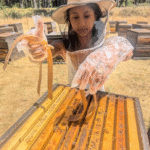
Fig. 2 The filter paper strips were a bit floppy, which made them tricky to insert (spreading the combs helps greatly). We applied all three types of strips at the rate of 1 strip per every 2.5 frames of bees, inserting them within the clusters.
The colonies did react to the hung strips, typically shifting their brood rearing away from them. Otherwise, the brood looked fine (Figure 3).
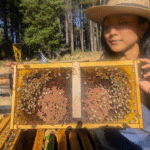
Fig. 3 The bees shifted brood rearing away from the strips.
Extended-Release Thymol
Last year we were very impressed by the efficacy of thymol-saturated soundboard blocks applied in a rim on top of the hive [[1]]. We used 40 g of thymol in that test, so I wondered how 30 g would work if applied between the brood chambers, rather than way up under the (hot) hive cover (Figure 4).

Fig. 4 I took this photo at the end of the trial, after lifting off the upper brood chamber. You can see how this colony built walls of propolis out around the blocks, which likely decreased their fumigation effect. Unlike oxalic acid, the aroma of thymol might taint the honey (not of concern if that honey is not to be sold).
Since we applied the thymol blocks in the outer corners, there did not appear to be much brood disruption in the center of the hives (Figures 5 & 6).

Fig. 5 At 28 days the thymol-treated hives had decent brood patterns (we often see spotty brood at this time of year, due to egg cannibalism by pollen-deficient nurse bees). Note that there was no propolization of the blocks in this hive.
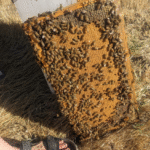
Fig. 6 However, in some hives at final grading the brood looked great!
Conditions During the Trial
The weather was generally hot and relatively dry, with no precipitation. I’ve shown our mite wash dates, daily high temperatures and average humidity in Figure 7.
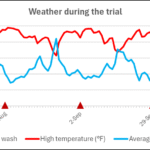
Fig. 7 We randomly assigned treatments [[2]] and installed the strips on 5-August as we took the mite counts, then took midway counts on 2-September, and final counts on 29-Sept. Weather data from nearby KCAGRASS50.
A Note on Our Mite Wash System
It took Rose and me only 145 minutes to take final mite wash counts from 78 hives (with me opening the hives and briefly inspecting them while shaking a bee sample, while Rose, working a portable agitator under a sunscreen, washed, counted, and recorded the data (Figure 8). That works out to only 1.7 minutes per wash for the two of us!
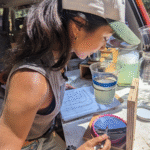
Fig. 8 We’ve developed a system that allows us to rapidly perform mite wash counts, with me opening the hives and taking the bee samples, and her popping the cups into the agitator, counting, recording, and refilling the cups.
Practical application: Our rapid mite wash system not only is a huge time saver for field research, but also the key for a selective breeding program for mite resistance, as well as for monitoring the varroa infestation rate in a commercial operation (to avoid large winter losses).
I’ll be writing about our system in an upcoming article. My helper Jacob McBride has already started a side gig fabricating the components (wash cups and portable agitators) for direct sale (Figure 9).
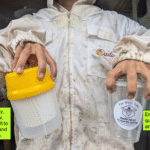
Fig. 9 The Solo cups are a much better fit to the hand, and drop the mites with minimal swirling agitation. Jake is offering 10-packs of my mite wash cup design for $20 plus shipping (great for purchase by beekeeping clubs to pass out to their members). You can contact him at forbeessake@gmail.com
Results and Discussion
I’ve plotted the progression of mite counts for the four treatments in Figure 10.
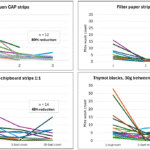
Fig. 10 Due to the number ending mite counts of zero, I couldn’t calculate percent reduction (you can’t divide by zero). So I simply divided the sum of the ending mite wash counts for each group by their starting sum to come up with an “absolute percent reduction of the total initial mite count,” which in this case, underestimates the effectiveness of the more successful treatments.
Practical application: I ran this experiment as a “comparative trial,” as opposed to a “test of efficacy,” so didn’t include an untreated Control group. Keep in mind that “percent reduction” underestimates “efficacy” (which involves comparison to an untreated Control group). At this time of season, we’d expect the mite wash counts to have at least doubled over the course of the trial, so the “efficacy” of these treatments can be presumed to have been much greater than the “percent reduction.”
Although all four treatments had achieved a relatively decent knockdown at 28 days, the General Filtration filter paper and Aluen CAP exhibited the best mite reduction at 55 days. The infestation rate rebound in the thymol group suggests that the 30 g dose was too low (or that the bees had propolized the blocks).
What surprised me is the great performance of the thin filter paper strips, which had largely lost their dampness by the endpoint. I have no idea as to why they performed better than the heavier chipboard strips.
As for as the performances of the 1:1 vs 1:2.5 OA:gly ratios, it’s hard to tease out any difference, due to the conflicting results of the chipboard and filter paper groups. I’m now in the middle of testing the amount of acidity transferred to the bees’ bodies by various oxalic application methods, which could help to explain — stay tuned!
Acknowledgements
Thanks again to my helpers Corrine Jones and Rose Pasetes.
Citations and Notes
[1] Oliver, R (2024) Extended-Release Thymol Blocks. ABJ April 2024
[2] We adjusted the assignments in the field to roughly set up a “randomized block” design for starting mite counts and colony strengths, assigning the highest starting mite count hives to the thymol group.



